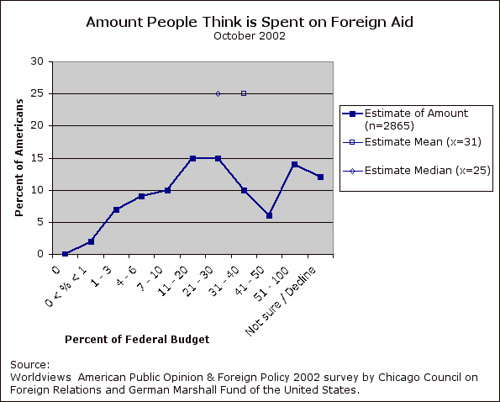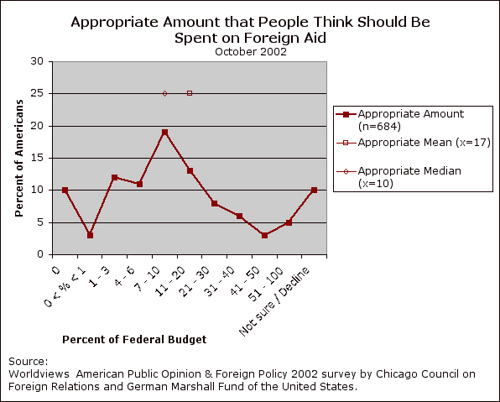I ended my last post with a few questions, one of which included: What percent of the federal budget do you think is spent on foreign aid?
As you can see in the graph above, the mean percentage response is 31, while the median is 25. Although the data in the graph above is from 2002, more recent studies have shown very similar results. If you focus only on those respondents with a college education, the median drops from 25 to 15.
This question is interesting, because these same people indicated that they believed we should spend less money than we do on foreign aid. These are people who would possibly advocate for a reduction in spending on foreign aid if that were proposed.
So how much does the U.S. really spend on foreign aid?
One percent.
But this gets even more interesting when you ask the same people what they think would be an appropriate percent to spend:
The mean is 17 and the median is 10!
This creates a very weird situation: you have a very large group of people who believe we spend too much on foreign aid, but have no idea how much we actually spend, and believe we should spend way more than we actually do! Confusing, right?
The only question that remains is what people would believe if they actually knew how much we spend on foreign aid. How would that then affect their opinion?
The United Nations se a goal that countries should set aside 0.7 percent of their Gross National Product. We’re switching measurement here from percent of budget to percent of GNP. Although the U.S. may spend more dollar-wise than other countries, among the developed nations of the world, it is absolute last in percent of spending by GNP, at around 0.1 percent – far below the U.N. recommendation.
One objection is that this doesn’t include private giving in the U.S., which many believe would greatly increase that amount.
However, if you include the private giving, the amount only increases to 0.14 – still at the bottom of the developed nations in the world!
The question I’d like to leave you with today is: does this have any ethical relevance? We’re just looking at the differences between beliefs and facts today. Looking at this information – do you think there are any ethical conclusions to be drawn?

